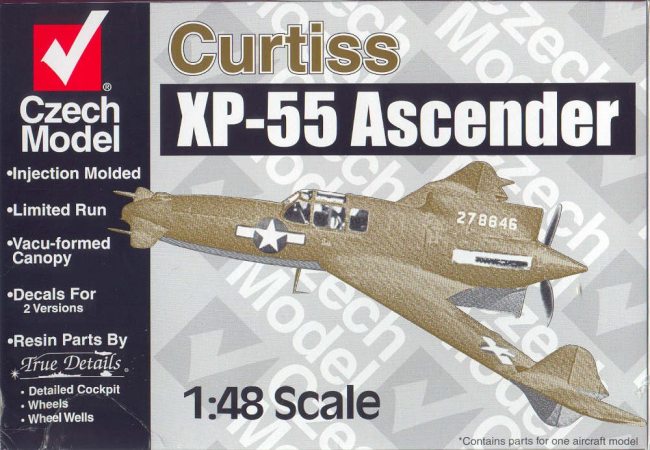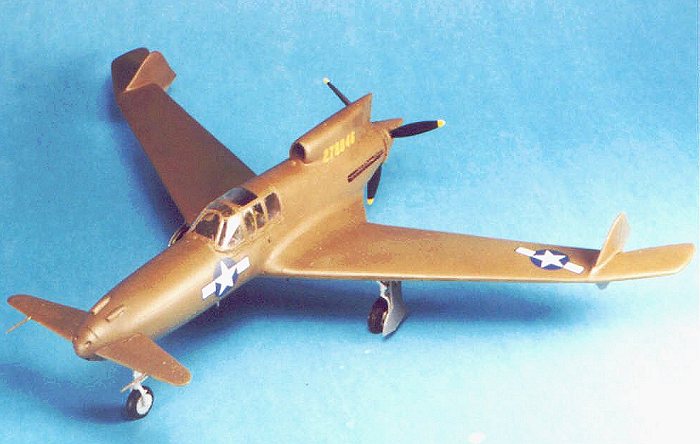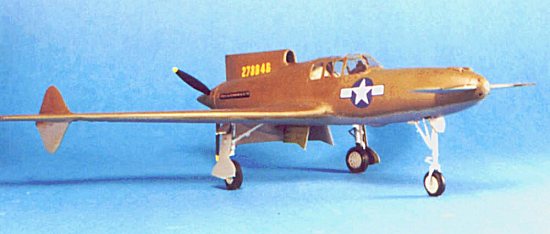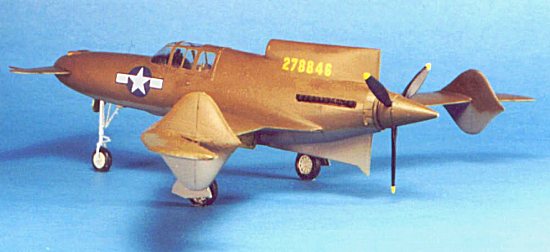
|
KIT: |
Czech Models 1/48 XP-55 'Ascender' |
|
KIT # |
4806 |
|
PRICE: |
$24.95 |
|
DECALS: |
see review |
|
REVIEW & |
Tom Cleaver |
|
NOTES: |
Mixed media, limited run kit |

|
HISTORY |
In 1938-39, the U.S. Army Air Corps began to realize just how far behind the international standards U.S. military aircraft design had fallen. The Seversky P-35 was only just attaining operational service, and anyone who compared its performance with what was known of the German Bf-109 and the British Spitfire and Hurricane could see just how far behind the U.S. was. The result was the creation of some fairly daring requirements, which resulted in such operational aircraft as the P-38 - the only US single-seat twin-engine fighter to see service during the Second World War - and the P-39, which introduced a novel position for the engine that allowed installation of a heavy nose armament. This period of adventurousness also resulted in some major failures, though these aircraft would be quite interesting in their design philosophies.
The pusher fighter concept had been around since 1915. The advantage of the design was it allowed a heavy armament on the centerline, though the use of booms for the tail unit made the resulting airplane more fragile than the traditional tractor designs. Use of modern aeronautical knowledge gave the promise of higher performance than traditional designs. The USAAC requirements of 1939 resulted in three very different responses to the concept of the pusher fighter. One, the Vultee XP-54, was the most traditional, with a central nacelle holding the cockpit and engine, with tail surfaces supported by booms to either side of the propeller arc. The other two were more radical, these being the Curtiss XP-55 and the Northrop XP-56. The XP-56 got around the tail boom problem by being essentially a flying wing with a central nacelle for installation of the powerplant and cockpit and thus dispensing with tail surfaces completely. The XP-55 put the tail surfaces in front of the engine, using a canard layout.
The canard is the layout of the first successful heavier-than-air airplane, the Wright Flyer, and has been recornized throughout the development of aviation as the design which makes the most aerodynamic sense - though it seems to violate the "rightness" of traditional design; this layout does not involve the twisting moment between wing and elevators of the traditional tractor design with the elevators on the tail. The advantage of such a design is that it uses less structure, hence weighs less, and thus provides a better power-to-weight ratio with resulting operational efficiency. That the canard is highly effective can be seen in the use of this with modern delta fighters like the Kfir.
The Curtiss XP-55, certainly among the most distinctive-looking aircraft ever produced by the American aviation industry, was given the company name of "Ascender," - generating thereby the nickname "Ass-ender" in recognition of its "tail first" design. It was originally to be powered (as were the XP-54 and XP-56) by the Pratt & Whitney 2,200 h.p. liquid-cooled 24-cylinder X-1800-A3G (H-2600). Cancellation of this engine in October 1942 meant that other powerplants had to be found for the airplanes. The XP-54 used the Lycoming XH-2470, generating 2,300 h.p., while the XP-46 went with the more reliable Pratt & Whitney R-2800. The XP-55 used the well-known Allison V-1710-95 - which provided power for the P-38, P-39 and P-40 - generating 1,125 h.p. at 15,500 feet. It was planned that the production version would use the Continental XIV-1430-3, which would give a top speed of 507 m.p.h.
The XP-54 appeared as a solo prototype, with first flight on January 15, 1943; the airplane was so big that the pilot entered the cockpit by means of an elevator seat. The originally projected performance included a speed of 510 m.p.h., to which the airplane never came close, showing a maximum speed of around 400 m.p.h. The Northrop XP-56, nicknamed "the flying bullet" for its fuselage shape, first flew September 26, 1943, crashing soon after. A second prototype was more successful, but by that time the coming age of jets made it obsolete sitting there.
Since the XP-54 really did not involve unknown aerodynamics with its traditional layout, and since the XP-56 utilized the "flying wing" layout which had already flown as the N-1M, there was no need for initial aerodynamic tests with these designs. Such was not the case with the XP-55. The canard layout was considered so radical that a full-size wooden prototype powered by a 275 h.p. Menasco was first flown in December 1941. This success of this proof-of-concept airplane led to approval of the three Allison-powered prototypes on July 10, 1942; the first - 42-278845 - flying July 13, 1943.
The XP-55's propeller could be jettisoned to allow a safe bailout by the pilot in an emergency. The rudders were mounted on fins at the wingtips, with small vertical fins above and below the engine for directional stability. The small nose-mounted elevator and high wing loading combined to produce unstable low-speed handling, and the first prototype went out of control during a stall test on November 15, 1943, the pilot successfully bailing out. The second prototype - 42-278846 - featured modified landing gear, enlarged vertical fins above and below the engine, an enlarged forward elevator and armament in the nose. The stall limits restricted its performance envelope, and the airplane was 1,000 lbs overweight. The airplane still displayed atrocious low-speed handling characteristics, making every landing "hairy." The third prototype, 42-278847, had the wing span extended four feet, and travel of the elevator increased. Similar modifications were made to the second aircraft. Problems with low-speed handling and engine cooling persisted, and high speed performance was disappointing. The USAAF cancelled the project in 1944, though the two aircraft continued to perform test work into 1945. 42-278847 crashed during a demonstration flight at Wright-Patterson on May 27, 1945, killing the pilot and a passing motorist. 42-278846 is the only survivor, and is now in the collection of the National Air and Space Museum.
Proof that the design was close to right is seen in the very successful Rutan Vari-Eze, which looks very much like a little XP-55, and zips along at 180 m.p.h. on only 100 h.p. The solution to the low-speed handling problem is found in the very large canard on the Vari-Eze, which gives a very powerful response to control inputs. The canard is also at a different incidence to the wing, so that when the wing stalls, the canard is still flying - the result is the nose dips about a foot, the wing starts flying again; the airplane is stall/spin-proof. The Vari-Eze was also the first to use Whitcomb Winglets, which give the wing performance throughout the speed range. The use of spoilers instead of rudders and ailerons solves all the problems found in the XP-55. Curtiss was close, but in aviation, close means no cigar.
|
THE KIT |

 Squadron
is to be commended for introducing the range of Czech Model kits that first
arrived in 1997. The line has presented such well-known oddballs as the Bell
XP-77 lightweight fighter prototype; the Yak-15, the first Russian jet fighter;
and the FJ-1 Fury, progenitor of the Sabre series. The XP-55, with its dramatic
look, has long interested modelers and is an excellent addition to the line. I
remember only one other kit of this airplane being available, a long
out-of-production vacuform. (Editor's note. MPM made this kit in 1/72 should
that be your scale of choice. There is also a 1/72 Combat vacuform kit if you
are really masochistic!)
Squadron
is to be commended for introducing the range of Czech Model kits that first
arrived in 1997. The line has presented such well-known oddballs as the Bell
XP-77 lightweight fighter prototype; the Yak-15, the first Russian jet fighter;
and the FJ-1 Fury, progenitor of the Sabre series. The XP-55, with its dramatic
look, has long interested modelers and is an excellent addition to the line. I
remember only one other kit of this airplane being available, a long
out-of-production vacuform. (Editor's note. MPM made this kit in 1/72 should
that be your scale of choice. There is also a 1/72 Combat vacuform kit if you
are really masochistic!)
The kit comes on two sprues of light grey plastic, providing the basic airframe, landing gear, and gear doors. The wheel wells, wheels, and cockpit are in resin from True Details. Two very clear vacuform canopies are provided, so that those (such as our Fearless Leader here at MM) who are vacuform-challenged will get two chances to create problems for themselves. (And don't think that we don't appreciate that! Ed) The decals are for 42-278846, the suriving second prototype, in its final configuration.
 The
limited-run injection-molded plastic has crisp surface detail, with petite
engraved panel lines and a minimum of flash. The trailing edges of the wings and
control surfaces are thin and sharp. Test-fitting of major components reveals no
problems. Overall, the kit looks relatively simple in production design and
should be a good first model for those who have not done a limited-run kit
before.
The
limited-run injection-molded plastic has crisp surface detail, with petite
engraved panel lines and a minimum of flash. The trailing edges of the wings and
control surfaces are thin and sharp. Test-fitting of major components reveals no
problems. Overall, the kit looks relatively simple in production design and
should be a good first model for those who have not done a limited-run kit
before.
Overall:
A well-done kit of an interesting airplane that will look highly distinctive when it is complete and sitting on your display shelf.
If you would like your product reviewed fairly and quickly by a site that has over 1,000 visits a day, please contact me or see other details in the Note to Contributors.